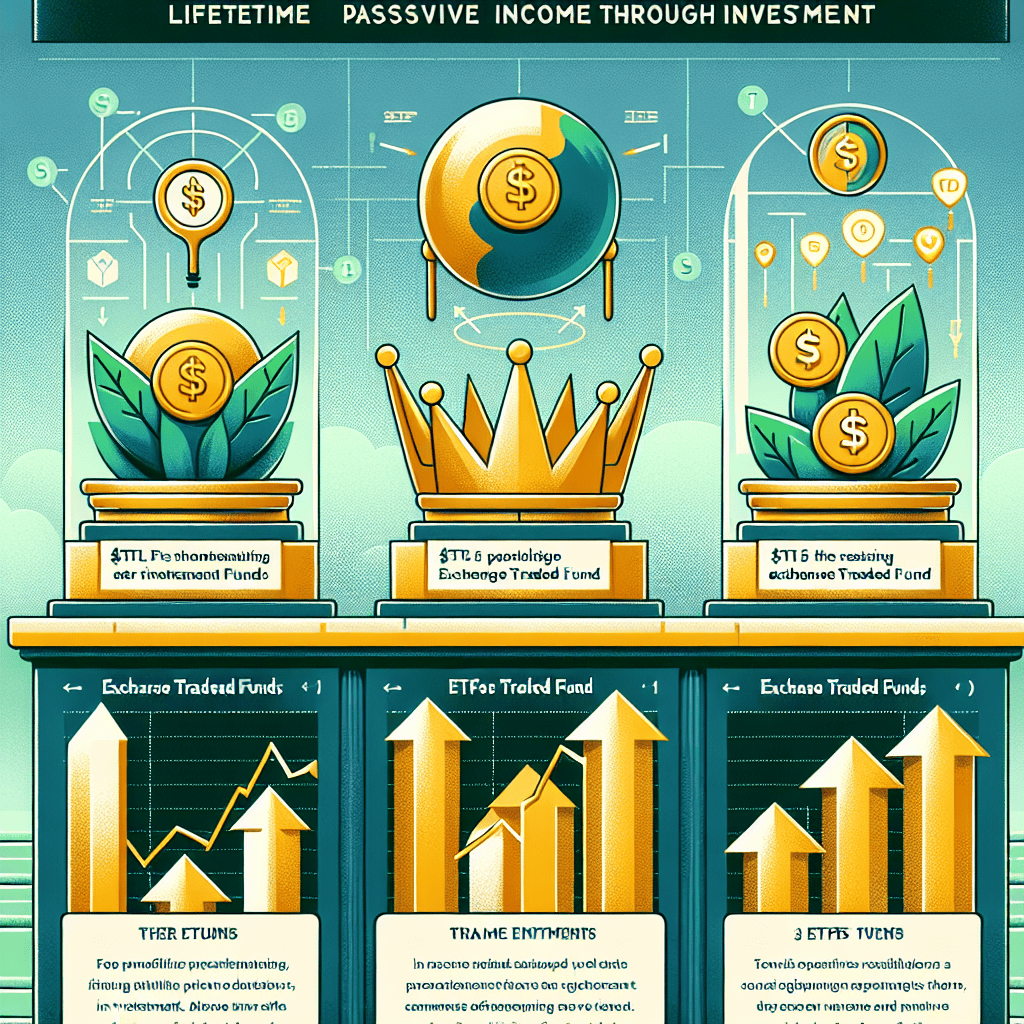“Secure Your Future: Discover the Top 3 ETFs for Lifetime Passive Income”
Introduction
Investing in exchange-traded funds (ETFs) has become an increasingly popular strategy for those seeking to build a lifetime of passive income. ETFs offer a diversified, low-cost, and flexible approach to investing, making them an attractive option for both novice and seasoned investors. By focusing on ETFs that prioritize dividend yields and long-term growth, investors can create a steady stream of income that requires minimal active management. In this guide, we explore the top three ETFs that stand out as excellent choices for generating lifetime passive income, each offering unique benefits and exposure to different sectors of the market. These ETFs not only provide the potential for consistent income but also the opportunity for capital appreciation, making them ideal for those looking to secure their financial future.
Understanding Lifetime Passive Income: The Basics of ETF Investments
Lifetime passive income is a financial goal that many aspire to achieve, and investing in Exchange-Traded Funds (ETFs) is a popular strategy to reach this objective. ETFs offer a diversified, low-cost, and relatively low-risk investment option, making them an attractive choice for both novice and seasoned investors. Understanding the basics of ETF investments is crucial for anyone looking to secure a steady stream of passive income over their lifetime.
To begin with, ETFs are investment funds that are traded on stock exchanges, much like individual stocks. They hold a collection of assets, such as stocks, bonds, or commodities, and are designed to track the performance of a specific index. This structure allows investors to gain exposure to a broad market segment without having to purchase each individual asset. Consequently, ETFs provide diversification, which is a key principle in reducing investment risk.
One of the top ETFs to consider for lifetime passive income is the Vanguard Total Stock Market ETF (VTI). This ETF aims to track the performance of the CRSP US Total Market Index, which includes large-, mid-, small-, and micro-cap stocks. By investing in VTI, individuals gain exposure to the entire U.S. stock market, which historically has shown strong long-term growth. The fund’s low expense ratio further enhances its appeal, as it allows investors to retain more of their returns over time. Moreover, VTI’s broad diversification helps mitigate the impact of volatility in any single sector or company, making it a stable choice for those seeking consistent income.
In addition to VTI, the iShares Core Dividend Growth ETF (DGRO) is another excellent option for generating passive income. DGRO focuses on U.S. companies that have a history of consistently growing their dividends. This ETF is particularly appealing to income-focused investors, as dividend growth is often a reliable indicator of a company’s financial health and stability. By investing in DGRO, individuals can benefit from both capital appreciation and a steady stream of dividend income. Furthermore, the fund’s emphasis on quality companies with strong fundamentals reduces the risk of dividend cuts, providing a more secure income source.
Lastly, the SPDR Bloomberg Barclays High Yield Bond ETF (JNK) offers a different approach to passive income through exposure to high-yield corporate bonds. While this ETF carries a higher risk compared to the previous two, it also offers the potential for higher returns. JNK invests in a diversified portfolio of below-investment-grade bonds, which typically offer higher yields to compensate for their increased risk. For investors willing to accept this risk, JNK can provide a substantial income stream, especially in a low-interest-rate environment. It is important, however, to balance such investments with more stable options to maintain a well-rounded portfolio.
In conclusion, achieving lifetime passive income through ETF investments requires a strategic approach that balances risk and reward. By considering ETFs like VTI, DGRO, and JNK, investors can create a diversified portfolio that offers both growth potential and income stability. As with any investment decision, it is essential to conduct thorough research and consider one’s financial goals and risk tolerance. With careful planning and a long-term perspective, ETFs can be a powerful tool in building a sustainable passive income stream.
Top 3 ETFs for Lifetime Passive Income: A Comprehensive Guide
Investing in exchange-traded funds (ETFs) has become an increasingly popular strategy for individuals seeking to generate lifetime passive income. ETFs offer a diversified portfolio of assets, often with lower fees than mutual funds, making them an attractive option for both novice and seasoned investors. As the financial landscape continues to evolve, identifying the right ETFs to invest in can be a crucial step toward securing a stable financial future. In this comprehensive guide, we will explore the top three ETFs that have consistently demonstrated the potential to provide lifetime passive income.
To begin with, the Vanguard Total Stock Market ETF (VTI) is a compelling choice for investors aiming to capture the broad U.S. equity market. VTI seeks to track the performance of the CRSP US Total Market Index, which includes large-, mid-, small-, and micro-cap stocks. This extensive diversification reduces the risk associated with investing in individual stocks while offering exposure to the entire U.S. stock market. Moreover, VTI is known for its low expense ratio, which enhances the net returns for investors. Over the years, this ETF has delivered consistent growth, making it a reliable option for those looking to build wealth over the long term. By reinvesting dividends and capital gains, investors can harness the power of compounding, thereby generating a steady stream of passive income.
Transitioning to another promising ETF, the iShares Core Dividend Growth ETF (DGRO) focuses on companies with a history of consistently growing their dividends. DGRO tracks the performance of the Morningstar US Dividend Growth Index, which includes companies that have increased their dividends for at least five consecutive years. This ETF is particularly appealing to income-focused investors, as it provides exposure to high-quality companies with strong fundamentals and a commitment to returning capital to shareholders. The emphasis on dividend growth not only offers the potential for income generation but also provides a hedge against inflation, as rising dividends can help maintain purchasing power over time. Furthermore, DGRO’s diversified portfolio spans various sectors, reducing the impact of sector-specific volatility on overall returns.
Finally, the Invesco QQQ Trust (QQQ) presents an opportunity for investors seeking exposure to the technology sector, which has been a significant driver of market growth in recent years. QQQ tracks the Nasdaq-100 Index, comprising 100 of the largest non-financial companies listed on the Nasdaq Stock Market. This ETF is heavily weighted toward technology giants such as Apple, Microsoft, and Amazon, which have consistently delivered robust earnings and revenue growth. While QQQ may exhibit higher volatility compared to more diversified ETFs, its focus on innovative companies with strong growth prospects can lead to substantial capital appreciation over time. For investors with a higher risk tolerance, QQQ offers the potential for significant passive income through both capital gains and dividends.
In conclusion, selecting the right ETFs is a critical component of building a portfolio that can generate lifetime passive income. The Vanguard Total Stock Market ETF, iShares Core Dividend Growth ETF, and Invesco QQQ Trust each offer unique advantages, catering to different investment goals and risk appetites. By incorporating these ETFs into a diversified investment strategy, individuals can position themselves to benefit from the growth potential of the stock market while enjoying the peace of mind that comes with a steady stream of passive income. As always, it is essential for investors to conduct thorough research and consider their financial objectives before making investment decisions.
How to Choose the Best ETFs for Long-Term Passive Income
When considering long-term passive income, exchange-traded funds (ETFs) present a compelling option for investors seeking a diversified and relatively low-maintenance investment vehicle. ETFs offer the advantage of pooling resources into a basket of securities, which can include stocks, bonds, or other assets, thereby spreading risk and potentially enhancing returns. However, selecting the right ETFs for generating lifetime passive income requires careful consideration of several factors. By focusing on the top three ETFs that align with these criteria, investors can position themselves for sustained financial growth.
To begin with, it is essential to evaluate the underlying assets of an ETF. A well-chosen ETF should have a diversified portfolio that includes stable, income-generating assets. For instance, the Vanguard Dividend Appreciation ETF (VIG) is a popular choice among income-focused investors. This ETF targets companies with a history of increasing dividends over time, which can provide a reliable income stream. By investing in companies with strong financial health and a commitment to returning capital to shareholders, VIG offers a balance of growth and income potential.
In addition to asset composition, the expense ratio of an ETF is a critical factor to consider. Lower expense ratios mean that more of the investment’s returns are retained by the investor, rather than being consumed by management fees. The Schwab U.S. Dividend Equity ETF (SCHD) is noteworthy in this regard, as it boasts one of the lowest expense ratios in its category. This ETF focuses on high-dividend-yielding U.S. stocks, providing investors with a cost-effective way to access a steady stream of income. The combination of low fees and a focus on dividend yield makes SCHD an attractive option for those seeking long-term passive income.
Furthermore, the historical performance and stability of an ETF should not be overlooked. While past performance is not indicative of future results, it can offer insights into how an ETF might behave under various market conditions. The iShares Select Dividend ETF (DVY) has demonstrated resilience and consistent performance over the years. By investing in a diversified portfolio of U.S. companies known for paying dividends, DVY has established itself as a reliable source of income. Its track record of stability and income generation makes it a strong candidate for investors aiming to build a passive income stream.
Transitioning from the selection criteria to the broader implications, it is important to recognize that investing in ETFs for passive income is not without risks. Market volatility, interest rate fluctuations, and economic downturns can impact the performance of even the most carefully chosen ETFs. Therefore, it is prudent for investors to maintain a diversified portfolio that includes a mix of asset classes and investment strategies. This approach can help mitigate risks and enhance the potential for long-term income generation.
In conclusion, choosing the best ETFs for long-term passive income involves a thorough analysis of asset composition, expense ratios, and historical performance. By focusing on ETFs like VIG, SCHD, and DVY, investors can access diversified portfolios that offer a balance of growth and income potential. While no investment is without risk, a well-considered ETF strategy can serve as a cornerstone for building a sustainable passive income stream, providing financial security and peace of mind for the future.
Diversifying Your Portfolio: The Role of ETFs in Lifetime Passive Income

In the pursuit of lifetime passive income, diversifying one’s investment portfolio is a crucial strategy, and Exchange-Traded Funds (ETFs) play a significant role in achieving this goal. ETFs offer a unique blend of diversification, liquidity, and cost-effectiveness, making them an attractive option for investors seeking to generate steady income streams over the long term. By investing in a carefully selected mix of ETFs, individuals can harness the power of the stock market while mitigating risks associated with individual stock investments. In this context, we explore the top three ETFs that can serve as foundational components of a diversified portfolio aimed at generating lifetime passive income.
To begin with, the Vanguard Total Stock Market ETF (VTI) is an excellent choice for investors looking to gain broad exposure to the U.S. equity market. This ETF tracks the performance of the CRSP US Total Market Index, encompassing large-, mid-, small-, and micro-cap stocks. By investing in VTI, individuals can benefit from the growth potential of the entire U.S. stock market, which historically has delivered robust returns over the long term. Moreover, VTI’s low expense ratio enhances its appeal, allowing investors to retain more of their returns. As a core holding in a diversified portfolio, VTI provides a solid foundation for generating passive income through capital appreciation and dividend payouts.
Transitioning to international markets, the iShares MSCI ACWI ex U.S. ETF (ACWX) offers investors exposure to global equities outside the United States. This ETF tracks the MSCI All Country World Index ex USA, which includes stocks from both developed and emerging markets. By incorporating ACWX into a portfolio, investors can diversify their income sources geographically, reducing reliance on the U.S. market and capturing growth opportunities in other regions. The inclusion of emerging markets is particularly advantageous, as these economies often exhibit higher growth rates compared to developed markets. Consequently, ACWX can enhance a portfolio’s potential for capital appreciation and dividend income, contributing to a more balanced and resilient income stream.
Finally, the Vanguard Real Estate ETF (VNQ) provides exposure to the real estate sector, a vital component of a diversified income-focused portfolio. Real estate investment trusts (REITs), which form the backbone of VNQ, are known for their ability to generate consistent income through rental payments and property appreciation. By investing in VNQ, individuals can tap into the income-generating potential of commercial real estate, including office buildings, shopping centers, and residential properties. Furthermore, VNQ’s inclusion in a portfolio can act as a hedge against inflation, as real estate values and rental incomes tend to rise with inflationary pressures. This characteristic makes VNQ an attractive option for investors seeking to preserve their purchasing power while generating passive income.
In conclusion, the strategic inclusion of ETFs such as VTI, ACWX, and VNQ in an investment portfolio can significantly enhance an investor’s ability to generate lifetime passive income. These ETFs offer diversified exposure to various asset classes and geographic regions, thereby reducing risk and increasing the potential for steady income streams. By leveraging the benefits of ETFs, investors can build a robust portfolio that not only withstands market fluctuations but also capitalizes on growth opportunities across different sectors and regions. As such, ETFs play an indispensable role in the pursuit of financial independence and long-term wealth accumulation.
Analyzing the Performance of Top ETFs for Lifetime Passive Income
Investing in exchange-traded funds (ETFs) has become an increasingly popular strategy for those seeking lifetime passive income. ETFs offer a diversified portfolio of assets, often with lower fees than mutual funds, making them an attractive option for both novice and seasoned investors. As we delve into the performance of the top ETFs for generating lifetime passive income, it is essential to consider factors such as historical performance, dividend yield, and expense ratios. By analyzing these elements, investors can make informed decisions that align with their financial goals.
One of the most prominent ETFs for passive income is the Vanguard Dividend Appreciation ETF (VIG). This ETF focuses on companies with a strong track record of increasing dividends over time. Historically, VIG has demonstrated consistent performance, driven by its investment in high-quality companies with robust financial health. The ETF’s emphasis on dividend growth rather than high current yield ensures that investors benefit from compounding returns over the long term. Furthermore, VIG’s low expense ratio enhances its appeal, allowing investors to retain more of their returns. As a result, VIG is often recommended for those seeking a reliable source of passive income.
Transitioning to another noteworthy option, the iShares Select Dividend ETF (DVY) offers a different approach by targeting companies with high dividend yields. This ETF is designed to provide investors with immediate income through dividends, making it an attractive choice for those who prioritize current cash flow. DVY’s portfolio includes a diverse range of sectors, which helps mitigate risk and provides stability. While its focus on high-yield stocks can lead to greater volatility compared to dividend growth ETFs, DVY’s historical performance has shown resilience, particularly during periods of economic uncertainty. The ETF’s moderate expense ratio further contributes to its suitability for income-focused investors.
In addition to VIG and DVY, the Schwab U.S. Dividend Equity ETF (SCHD) stands out as a compelling option for lifetime passive income. SCHD combines elements of both dividend growth and high yield, offering a balanced approach that appeals to a broad range of investors. The ETF’s strategy involves selecting companies with strong financial metrics and a history of consistent dividend payments. This dual focus ensures that investors benefit from both immediate income and long-term growth potential. SCHD’s competitive expense ratio and solid historical performance make it a formidable contender in the realm of income-generating ETFs.
As we consider these top ETFs, it is crucial to recognize that past performance is not indicative of future results. Market conditions, economic factors, and changes in interest rates can all impact the performance of dividend-focused ETFs. Therefore, investors should conduct thorough research and consider their risk tolerance and investment horizon before committing to any ETF. Diversification across multiple ETFs or asset classes can also help mitigate risk and enhance the potential for stable, long-term income.
In conclusion, the Vanguard Dividend Appreciation ETF, iShares Select Dividend ETF, and Schwab U.S. Dividend Equity ETF each offer unique advantages for those seeking lifetime passive income. By understanding the nuances of each ETF’s strategy and performance, investors can make informed decisions that align with their financial objectives. As with any investment, careful consideration and ongoing evaluation are key to achieving sustainable passive income over the long term.
Risk Management Strategies for Investing in ETFs for Passive Income
Investing in exchange-traded funds (ETFs) for passive income is an increasingly popular strategy among investors seeking to build a reliable income stream without the need for constant portfolio management. However, like any investment, ETFs come with their own set of risks that must be managed effectively to ensure long-term success. Understanding and implementing risk management strategies is crucial for investors aiming to achieve lifetime passive income through ETFs. This article explores three key risk management strategies that can help investors mitigate potential pitfalls while investing in ETFs for passive income.
To begin with, diversification is a fundamental risk management strategy that can significantly reduce the volatility of an investment portfolio. By spreading investments across a variety of asset classes, sectors, and geographic regions, investors can minimize the impact of any single underperforming asset on their overall portfolio. For instance, investing in a mix of equity, bond, and real estate ETFs can provide a balanced exposure to different market conditions. Equity ETFs offer growth potential, bond ETFs provide stability and income, and real estate ETFs can offer both income and inflation protection. This diversified approach not only helps in managing risk but also enhances the potential for consistent income generation over time.
In addition to diversification, it is essential to consider the expense ratios of the ETFs in which one invests. Expense ratios represent the annual fees that fund managers charge to manage the ETF, and they can have a significant impact on the net returns of an investment. Lower expense ratios mean that more of the investment’s returns are retained by the investor, which is particularly important for those seeking passive income. Therefore, selecting ETFs with competitive expense ratios is a prudent risk management strategy. Investors should compare the expense ratios of similar ETFs and opt for those that offer the best value without compromising on quality or performance.
Another critical risk management strategy is to regularly review and rebalance the ETF portfolio. Market conditions and personal financial goals can change over time, necessitating adjustments to the investment portfolio. Rebalancing involves realigning the weightings of the portfolio’s assets to maintain the desired level of risk and return. For example, if equity markets have performed exceptionally well, an investor’s portfolio may become overweight in equities, increasing exposure to market volatility. By rebalancing, investors can sell a portion of the overperforming assets and reinvest in underperforming ones, thereby maintaining the intended asset allocation and risk profile. Regular portfolio reviews and rebalancing ensure that the investment strategy remains aligned with the investor’s long-term objectives.
Moreover, it is important to stay informed about the economic and market trends that could impact the performance of ETFs. Keeping abreast of interest rate changes, inflation trends, and geopolitical events can provide valuable insights into potential risks and opportunities. This knowledge enables investors to make informed decisions about when to adjust their portfolios or explore new investment opportunities. Staying informed also helps investors anticipate market shifts and respond proactively, rather than reactively, to changes in the investment landscape.
In conclusion, while investing in ETFs for passive income offers numerous benefits, it is not without risks. By employing strategies such as diversification, focusing on expense ratios, regularly rebalancing portfolios, and staying informed about market trends, investors can effectively manage these risks. These strategies not only safeguard the investment but also enhance the potential for achieving a stable and sustainable passive income stream over the long term.
Future Trends in ETFs: Maximizing Lifetime Passive Income Opportunities
In the ever-evolving landscape of investment opportunities, Exchange-Traded Funds (ETFs) have emerged as a popular choice for those seeking to maximize lifetime passive income. As investors increasingly prioritize financial security and long-term wealth accumulation, understanding future trends in ETFs becomes crucial. Among the myriad of options available, three ETFs stand out for their potential to generate sustainable passive income: Vanguard Dividend Appreciation ETF (VIG), iShares Select Dividend ETF (DVY), and Schwab U.S. Dividend Equity ETF (SCHD).
To begin with, the Vanguard Dividend Appreciation ETF (VIG) is a compelling choice for investors aiming to secure a steady stream of income. This ETF focuses on companies with a strong track record of increasing dividends over time, thereby offering a reliable source of income growth. As companies within VIG’s portfolio continue to enhance their dividend payouts, investors can benefit from both capital appreciation and a rising income stream. Furthermore, VIG’s diversified holdings across various sectors mitigate risks associated with market volatility, making it an attractive option for those seeking stability in their investment portfolio.
Transitioning to another promising ETF, the iShares Select Dividend ETF (DVY) offers a unique approach to income generation by targeting high-yielding U.S. stocks. This ETF is designed to provide investors with exposure to companies that consistently pay above-average dividends. By focusing on high-yield stocks, DVY aims to deliver a robust income stream, appealing to those who prioritize immediate cash flow. Additionally, the ETF’s emphasis on quality and financial health ensures that the selected companies have the capacity to sustain their dividend payments, thereby reducing the risk of income disruption. As a result, DVY presents a viable option for investors seeking to enhance their passive income through high-yield investments.
Moreover, the Schwab U.S. Dividend Equity ETF (SCHD) offers a balanced approach to income generation by combining high dividend yields with strong growth potential. This ETF selects companies based on their dividend yield, dividend growth, and overall financial strength, ensuring a well-rounded portfolio that caters to both income and growth-oriented investors. SCHD’s focus on financially robust companies with a history of dividend increases provides a dual benefit: a steady income stream and the potential for capital appreciation. Consequently, SCHD is an excellent choice for those looking to achieve a harmonious blend of income and growth in their investment strategy.
In light of these considerations, it is evident that ETFs like VIG, DVY, and SCHD offer promising avenues for maximizing lifetime passive income. As the investment landscape continues to evolve, these ETFs provide a strategic means to capitalize on dividend growth and high-yield opportunities. By incorporating such ETFs into their portfolios, investors can position themselves to benefit from both immediate income and long-term wealth accumulation. Ultimately, understanding and leveraging future trends in ETFs can empower investors to achieve financial security and independence, ensuring a stable and prosperous future. As the pursuit of lifetime passive income becomes increasingly relevant, these top ETFs stand out as valuable tools in the investor’s arsenal, offering a pathway to sustained financial success.
Q&A
1. **What is a top ETF for lifetime passive income focused on dividends?**
– **Vanguard Dividend Appreciation ETF (VIG):** This ETF focuses on companies with a strong track record of increasing dividends over time, providing a reliable source of passive income.
2. **Which ETF is known for its broad market exposure and income potential?**
– **SPDR S&P 500 ETF Trust (SPY):** As one of the largest and most well-known ETFs, SPY offers exposure to the S&P 500, providing both growth and dividend income potential.
3. **What is a recommended ETF for international dividend income?**
– **iShares International Select Dividend ETF (IDV):** This ETF targets high dividend-paying companies outside the U.S., offering diversification and income from international markets.
4. **Which ETF focuses on high-yield corporate bonds for income?**
– **iShares iBoxx $ High Yield Corporate Bond ETF (HYG):** This ETF invests in high-yield corporate bonds, providing higher income potential through interest payments.
5. **What ETF is suitable for those seeking income from real estate investments?**
– **Vanguard Real Estate ETF (VNQ):** VNQ invests in real estate investment trusts (REITs), offering income through dividends from real estate holdings.
6. **Which ETF is known for its focus on utility companies for stable income?**
– **Utilities Select Sector SPDR Fund (XLU):** This ETF targets utility companies, known for their stable and consistent dividend payments, providing a steady income stream.
7. **What is a balanced ETF that combines both growth and income?**
– **iShares Core Growth Allocation ETF (AOR):** AOR offers a balanced approach by investing in a mix of equities and fixed income, aiming for both growth and income over the long term.
Conclusion
Investing in ETFs (Exchange-Traded Funds) for lifetime passive income is a strategic approach to building wealth over time. The top three ETFs to consider for this purpose typically include those that focus on dividend growth, broad market exposure, and low expense ratios. Firstly, a Dividend Aristocrats ETF, which includes companies with a history of increasing dividends, can provide a reliable income stream. Secondly, a Total Stock Market ETF offers diversification across the entire U.S. stock market, balancing risk and potential returns. Lastly, an International Dividend ETF can add global exposure and additional income opportunities. By investing in these types of ETFs, investors can create a diversified portfolio that generates consistent passive income, leveraging the power of compounding and market growth over the long term.





